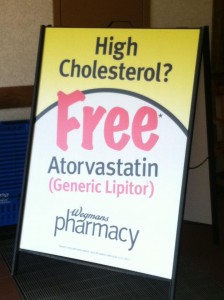
I spotted this sign yesterday at my local Wegmans, the family-owned grocery chain founded in upstate NY and growing down the northeast corridor of the U.S. Many months ago, a similar sign promoted “free antibiotics” at the store.
What does a grocery chain’s pharmacy doling out “Free” [asterisked] generic Lipitor mean to the larger health ecosystem?
On the upside, health is where we live, work, play and pray, as Dr. Regina Benjamin, the Surgeon General, has said. This has become a mantra for us at THINK-Health, and regular Health Populi readers may be tiring of my repeated use of this phrase. Call it Primary Care, Everywhere.
Be that as it may, it’s a crucial concept in this era of consumer-driven health and accountable care. Without patient and health/wellness engagement, making people co-creators of their own health and the health of those for whom they care, the nation has no hope of either improving public health outcomes or bending that nastily ever-increasing cost-curve — the long-term driver of the U.S. budget deficit.
In addition to community-based care and patient engagement where people ‘are,’ the role of the pharmacy in the community is key for healthy people, and will be playing a growing role, especially where pharmacies are co-located with grocery and Big Box stores. Wherever health care products and services can be made more convenient is a reminder about whole health, and provides greater access for people who need to fill prescriptions, as well as keep their over-the-counter, supplements, and complementary medicines supply cabinets fresh and filled.
Those are a few of the key positives of this sign. But there are other issues to tease out, as well.
“There ain’t no such thing as a free lunch,” wrote Robert Heinlein, science fiction writer of The Moon is a Harsh Mistress, in 1966. The iconic economist Milton Friedman wrote the book, There is No Such Thing as a Free Lunch in 1975. For pharmacies, getting foot traffic into the back of the store for a free or cheap prescription is a smart business tactic to get foot traffic into the (more profitable) front of the store to purchase beauty products, magazines, durable medical equipment, chewing gum, and detergent. For a pharmacy co-located in a grocery store, it means selling more milk, eggs, produce and canned goods, getting more shopping dollars out of consumers picking up a prescription — even a so-called free one.
Another thread to consider is the nature of a statin. Lowering high cholesterol is often amenable to changing lifestyle behaviors, such as diet and exercise. In this case, “lunch” could be reconfigured as lean and green so that perhaps a newly-diagnosed patient needing a statin might wean herself off of it even before filling the prescription for a statin — even a free one.
Health Populi’s Hot Points: The lure of “free” thus isn’t so free at all when it comes to patient empowerment. The first step in therapy for high cholesterol should be lifestyle changes. This worked well for a close family member, whose genetic code was predisposed to high cholesterol but for whom some aggressive and regular exercise, coupled with red yeast rice, helped to lower his cholesterol number.
Wegmans and other grocery purveyors are in the perfect position to foster healthy eating and lifestyle behavior change, as well as provide necessary prescription drugs when required. The August 25 2012 issue of the New York Times wrote about Employing Dietitians Paying Off for Supermarkets. “Hy-Vee is the only grocery chain in the country that posts a registered dietitian in almost every one of its 235 stores. In rural areas, some of its more than 190 dietitians serve a cluster of stores,” the Times reported.
Hy-Vee isn’t the only food chain engaging the services of nutritionists. In fact, Wegmans’ lead dietician, Jane Andrews, is considered the “grande dame of supermarket dietitians,” the Times says. She started at Wegmans in 1988 — very early before this became a trend. Other grocery chains with nutritionists on staff including Bashas’, Giant Eagle, H-E-B, and Meijer, among others.
So groceries know food = health, and pharmacies = profitability. Getting nutritionists central into these equations will be helpful for putting people-patients in the center of the evolving health ecosystem.




 Interviewed live on BNN Bloomberg (Canada) on the market for GLP-1 drugs for weight loss and their impact on both the health care system and consumer goods and services -- notably, food, nutrition, retail health, gyms, and other sectors.
Interviewed live on BNN Bloomberg (Canada) on the market for GLP-1 drugs for weight loss and their impact on both the health care system and consumer goods and services -- notably, food, nutrition, retail health, gyms, and other sectors. Thank you, Feedspot, for
Thank you, Feedspot, for  As you may know, I have been splitting work- and living-time between the U.S. and the E.U., most recently living in and working from Brussels. In the month of September 2024, I'll be splitting time between London and other parts of the U.K., and Italy where I'll be working with clients on consumer health, self-care and home care focused on food-as-medicine, digital health, business and scenario planning for the future...
As you may know, I have been splitting work- and living-time between the U.S. and the E.U., most recently living in and working from Brussels. In the month of September 2024, I'll be splitting time between London and other parts of the U.K., and Italy where I'll be working with clients on consumer health, self-care and home care focused on food-as-medicine, digital health, business and scenario planning for the future...